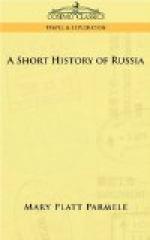At the same time there mingled with this another stream from Scandinavia, another judicial code which sanctioned private revenge, the pursuit of an assassin by all the relatives of the dead; also the ordeal by red-hot iron and boiling water. But to the native Slav race, corporal punishment, with its humiliations and its refinements of cruelty, was unknown until brought to it by stronger and wiser people from afar.
When we say that Russia was putting on a garment of civilization, let no one suppose we mean the people of Russia. It was the Princes, and their military and civil households; it was official Russia that was doing this. The people were still sowing and reaping, and sharing the fruit of their toil in common, unconscious as the cattle in their fields that a revolution was taking place, ready to be driven hither and thither, coerced by a power which they did not comprehend, their horizon bounded by the needs of the day and hour.
The elements constituting Russian society were the same in all the principalities. There was first the Prince. Then his official family, a band of warriors called the Drujina. This Drujina was the germ of the future state. Its members were the faithful servants of the Prince, his guard and his counselors. He could constitute them a court of justice, or could make them governors of fortresses (posadniki) or lieutenants in the larger towns. The Prince and his Drujina were like a family of soldiers, bound together by a close tie. The body was divided into three orders of rank: first, the simple guards; second, those corresponding to the French barons; and, third, the Boyars, the most illustrious of all, second only to the Prince. The Drujina was therefore the germ of aristocratic Russia, next below it coming the great body of the people, the citizens and traders, then the peasant, and last of all the slave.
Yaroslaf, the “legislator,” known as the Charlemagne of Russia, died in the year 1054. The Eastern and Western Empires, long divided in sentiment, were that same year separated in fact, when Pope Leo VI. excommunicated the whole body of the Church in the East.
With the death of Yaroslaf the first and heroic period in Russia closes. Sagas and legendary poems have preserved for us its grim outlines and its heroes, of whom Vladimir, the “Beautiful Sun of Kief,” is chief. Thus far there has been a unity in the thread of Russian history—but now came chaos. Who can relate the story of two centuries in which there have been 83 civil wars—18 foreign campaigns against one country alone, not to speak of the others—46 barbaric invasions, and in which 293 Princes are said to have disputed the throne of Kief and other domains! We repeat: Who could tell this story of chaos; and who, after it is told, would read it?




